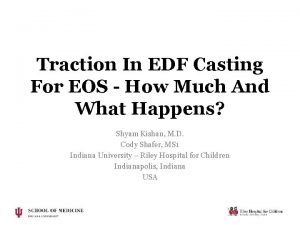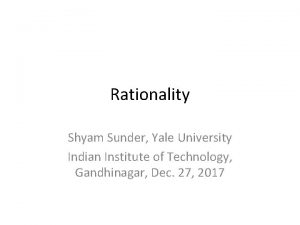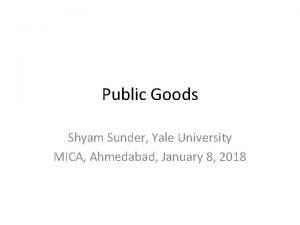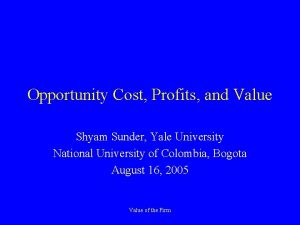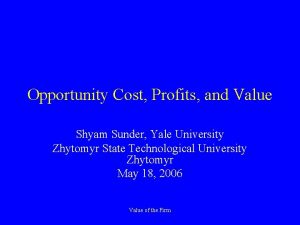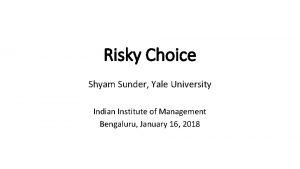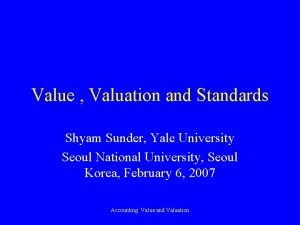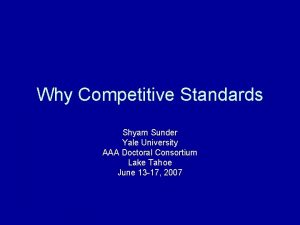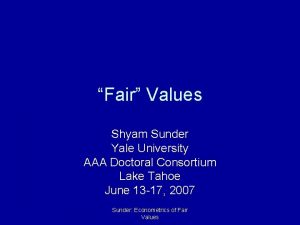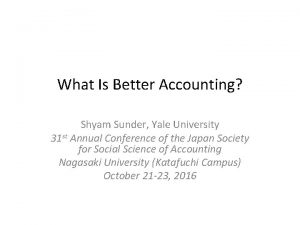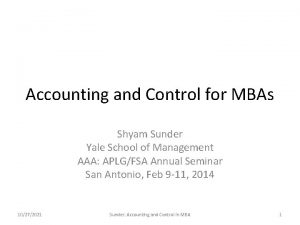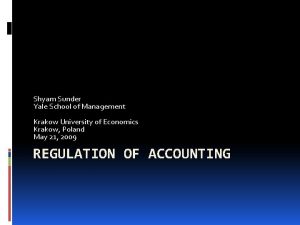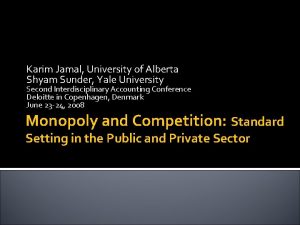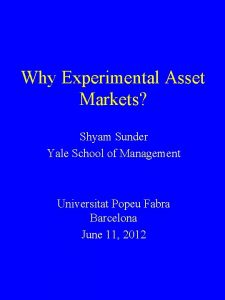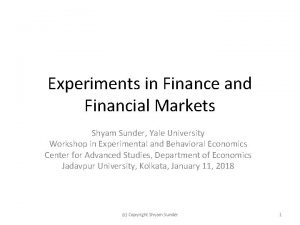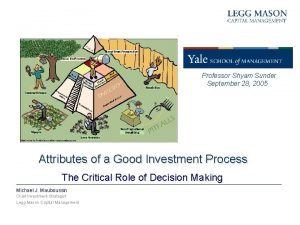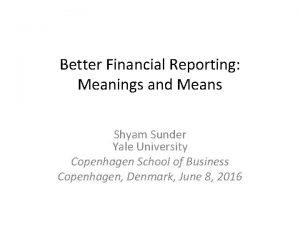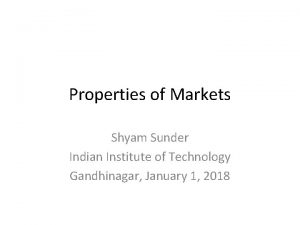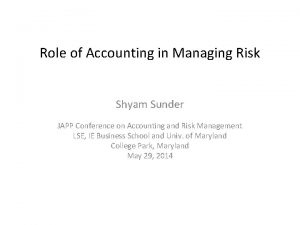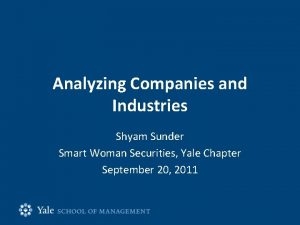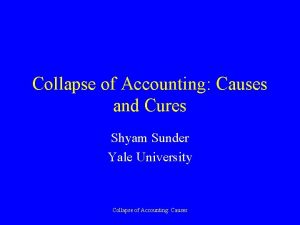Future RiskRegulating for Systemic Risks Shyam Sunder Yale





























- Slides: 29

Future Risk—Regulating for Systemic Risks Shyam Sunder, Yale University Conference on Ten Years after the Financial Crisis Columbia Universiry, New York, Dec. 7 -8, 2017

Daniel Friedman, R. Mark Isaac, Duncan James, and Shyam Sunder. 2014. Risky Curves: On the empirical failure of expected utility. London: Routledge. The broad economics challenge of understanding, explaining, and predicting risky choice by curved utility functions • Follow Markowitz: “Utility function is just a device for explaining and predicting responses to choices involving risk. ” • Harry Markowitz (Quoted in Rosett, 1967, p. 157) • Predictive content (out of sample, and out of context) is essential to value of a theory • No science, economics included, can be based on theories without documented predictive power (out-of-sample) • Need unambiguous definitions and methods of measurement Sunder: Risky Choice 2

History • D. Bernoulli (1738); Jevons, Marshall, Von Neumann Morgenstern (1943): curved utility (Bernoulli) functions to understand choice under risk combined with dispersion of outcomes as a measure of risk • This idea (EUT) is widely accepted in the field; theorists devise new parameterized curves (e. g. , CPT); experimenters devise protocols to elicit data and estimate the parameters • Meager empirical harvest: little stability in parameters outside the fitted context; power to predict out of sample poor-to-nonexistent; no convincing victories over naïve alternatives; surprisingly little insight into phenomena outside the lab (insurance, security, labor, forex markets, gambling, business cycles, etc. ) Sunder: Risky Choice 3

Measuring Individual Risk Preferences • Unambiguous definitions and methods of measurement at the heart of sciences • Seven decades of attempts to furnish empirical content to VNM theory include: • • Free form thought experiments of Friedman and Savage 1948, and Markowitz 1952); Both rejected Bernoulli’s proposal Sunder: Risky Choice 4

Free Form Thought Experiments Friedman and Savage 1948 Markowitz 1952 2 points of inflexion 3 points of inflexion Sunder: Risky Choice 5

Mosteller & Nogee 1951 Sunder: Risky Choice 6

Edwards (1955): FIG. 1. Experimentally determined individual utility curves. The 45° line in each graph is the curve which would be obtained if the subjective value of money were equal to its objective value. Sunder: Risky Choice 7

Grayson (1960) Sunder: Risky Choice 8

Parametrized Utility Functions: Pratt; Diamond, Rothschild, and Stiglitz (1964 -74) • Pratt; Diamond, Rothschild, and Stiglitz during this decade, EUT with dispersion-based measures of risk (e. g. , variance and Arrow-Pratt) were in the driver’s seat • Pure vs. speculative risk distinction of insurance theory and industry fell into disuse • Explosion of interest in EU with analysis of parameterized utility function, and giving empirical content to the VNM program through elicitation of choices over risky lotteries • To what extent did these elicitations yield dependable estimates of a person’s propensity to choose under risk? Sunder: Risky Choice 9

Examples of Parametric Estimation from Lab and Field Experiments: Absolute (ARA) and Relative (RRA) Risk Aversion • Certainty equivalent (Dillon and Scandizzo 1978) • Lottery choice from menu (Binswanger 1980) • Auctions • Becker-De. Groot-Marschak procedure • Holt-Laury procedure • Pie Chart procedures • Physiological measurements • Payment methods • BDM vs. auctions • Small and large stakes • Problem solving ability • Perception of institutions • Heuristics Sunder: Risky Choice 10

Binswanger’s Field Work with Indian Farmers • Binswanger (1980) used lottery choice and certainty equivalent elicitation methods • Different results from two methods • Only F is inconsistent with risk aversion • Landlord RA > tenants • No high stakes effect • “Luck” was best explanation • Farming investment decisions “cannot be explained by differences in their attitudes…” • Ditto Jacobson and Petrie 2007 Sunder: Risky Choice Lottery O A B D* C D E F Payoff if heads Payoff if tails 50 50 45 95 40 120 35 125 30 150 20 160 10 190 0 200 11

Becker-De. Groot-Marschak vs. Auctions • Isaac and James (2000): Estimated risk coefficients from different elicitation methods are • not only different, they are not even rank-preserving • Subjects identified to be far risk averse by one method of elicitation tend to be far risk seeking from the other method • Difficulty of reconciling the results with extant models Sunder: Risky Choice N 12

Where Are We Now? • Different ways of eliciting risk parameters in cash-motivated controlled economics experiments yield different results • Little evidence that EU (and its variations), based on elicited preferences, predict individual choice better than naïve alternatives • Estimation procedures applied to any choice data necessarily yield a risk coefficient; but exhibit little stability outside contexts • Perhaps the failure to find stable results with predictive content is the result • Perhaps Bernoulli functions may help us understand aggregate phenomena and furnish some consilience across macro domains Sunder: Risky Choice 13

Are Aggregate Level Phenomena in the Field Explained/Predicted Better by Curved Bernoulli Functions? Must not rule this out without examining the data. • Health, medicine, sports, illicit drugs • Gambling • Engineering • Insurance • Real estate • Bond markets • Stock markets • Uncovered interest rate parity • Equity premium • Aggregate model calibrations • Labor markets • Social/unemployment insurance • Central bank reserves Sunder: Risky Choice 14

Stock markets • Markowitz 1952/1959 presented variance as a measure of risk, tentatively, because of familiarity, convenience, and computability • Sharpe 1964 and Lintner 1965: Linear equilibrium relationship between expected return and covariance risk • Intensive research on empirical evidence on CAPM and diversification • Fama and French 1992: “Our tests do not support the most basic predictions of the SLB model, that average stock returns are positively related to market betas. ” • Fama and French 2004: “Unfortunately, the empirical record of the model is poor — poor enough to invalidate the way it is used in applications. . In the end, we argue that whether the model’s problems reflect weaknesses in theory or in its empirical implementation, the failure of the CAPM in empirical tests implies that most applications of the model are invalid. ” Sunder: Risky Choice 15

Stock Markets (2) • Brealey and Myers 2003: “There is no doubt that the evidence on the CAPM is less convincing than scholars once thought. But it will be very hard to reject the CAPM beyond all reasonable doubt. Since data and statistics are unlikely to give final answers, the plausibility of the CPAM will have to be weighed along with the empirical ‘facts’” Sunder: Risky Choice 16

Aggregate Level Evidence From the Field • The hope that curved Bernoulli functions, combined with dispersion concept of risk, might yield insights into a variety of socio-economic phenomena in the field waits to be fulfilled • Surprisingly little aggregate level insights or consilience across domains populated by the same agents: credit, insurance, corporate equity, real estate, currency markets, gambling, labor, and business cycles • Academic literature often assumes such functions, but attempts to tie the resulting models to data often lead to wildly different, and mutually inconsistent, implied innate preferences in specified populations. Sunder: Risky Choice 17

What is next? • Parameter r for the same population has to vary from 0. 15 to 14 (by about two orders of magnitude) to explain observations in various domains of our lives • Possible ways forward: • Alternative meanings/measures of risk • Looking for explanatory power in decision makers’ obseravable opportunity sets, real options, and net pay-offs, instead of in unobserved curved Bernoulli functions • Current work in evolution, learning theory, and neuroeconomics Sunder: Risky Choice 18

Attitudes to Risk • Depends on which meaning you have in mind • Harm/injury/loss: can anyone be risk-loving? • Dispersion meaning: aversion as well as love for risk is possible • Evidence on attitudes to dispersion risk Sunder: Risky Choice 19

Sunder: Risky Choice 20

Sunder: Risky Choice 21

Sunder: Risky Choice 22

Dispersion Meaning of Risk • Dispersion of a probability distribution is a measure of how far apart or dispersed the outcomes are. • Variance is one measure of dispersion (also, standard deviation, etc. ) • Which bet is more risky in this sense? • Win $1 or lose $1 on a coin toss • Win $10 or lose $10 on a coin toss • Second has higher dispersion, and is therefore more risky in the dispersion sense • Introduced by Daniel Bernoulli (1738) and Markowitz (1952) Sunder: Risky Choice 23

Sunder: Risky Choice 24

Relationship between Expected Loss vs. Standard Deviation (Friedman, Isaac, James, and Sunder, Risky Curves, Routledge 2014) 121 Lotteries with uniform distribution with different parameters 121 Lotteries on (-0. 5, 0. 5) with beta distribution with different parameters Sunder: Risky Choice 25

Discussion: Mark Roe and Michael Troege, “Containing Systemic Risk by Taxing Banks Properly” • Financial engineering (FE) ever present in financial regulation • Assessment of vulnerability of any proposals to FE • Securitization of mortgages was itself FE frustrating regulatory intent • How will FE react to the proposed change in tax law? • In the political environment of recent decades, what is the political economy of incentives in the financial industry vis-à-vis incentives of legislative and executive branches, their relative sizes, resources, and power? • If accomplished, how long will such reforms last? Sunder: Risky Choice 26

Viktoria Baklanova, “Money Market Funds a Decade After the Onset of the Crisis” • How should we assess if the reforms (liquidity fees and redemption gates) have reduced the risk of runs on money market funds going forward? • What is an acceptable societal economic trade-off between the risk of runs and the reduced liquidity? • What are the consequences of these reforms for the incentives and behavior of money market fund managers in the future? Will they be induced by these reforms to take more risk? • How do we find answers to such future oriented policy questions? Past data provides only limited help. Will laboratory experiments help yield some useful information? Sunder: Risky Choice 27

Agostino Capponi, et al. “Economics of Clearing Houses: Default Waterfall Requirements and Systemic Risk Implications” • Evidence from collaterals in cleared CDS market does not support the variance concept of risk • Even VAR has weak support. More extreme concepts such as maximal loss do much better in explaining the data • Points to the need for a more unified approach to the concept of risk across various elements of financial literature • Perhaps it is the time to take seriously Markowitz’ tentativeness in choosing variance as a measure of risk (for reasons of familiarity, convenience and computability) over tail risk concepts Sunder: Risky Choice 28

Thank You. Shyam. sundeer@yale. edu Sunder: Risky Choice
 Shyam sunder meaning
Shyam sunder meaning Future perfect and future continuous
Future perfect and future continuous Future perfect future continuous future perfect continuous
Future perfect future continuous future perfect continuous Shyam kishan md
Shyam kishan md Aunty vs boy
Aunty vs boy Future nurse future midwife
Future nurse future midwife Future plans and finished future actions
Future plans and finished future actions Future vs future perfect
Future vs future perfect Future in the past continuous
Future in the past continuous Perfect future continuous tense
Perfect future continuous tense Present past future sentences
Present past future sentences Present continuous plans
Present continuous plans Kondicional 1 engleski
Kondicional 1 engleski Future perfect and future continuous examples
Future perfect and future continuous examples Tense chart in english
Tense chart in english Rutin för avvikelsehantering
Rutin för avvikelsehantering Tack för att ni har lyssnat
Tack för att ni har lyssnat Läkarutlåtande för livränta
Läkarutlåtande för livränta Treserva lathund
Treserva lathund Mall debattartikel
Mall debattartikel Påbyggnader för flakfordon
Påbyggnader för flakfordon Tack för att ni lyssnade
Tack för att ni lyssnade En lathund för arbete med kontinuitetshantering
En lathund för arbete med kontinuitetshantering Tobinskatten för och nackdelar
Tobinskatten för och nackdelar Egg för emanuel
Egg för emanuel Atmosfr
Atmosfr Var finns arvsanlagen
Var finns arvsanlagen Lågenergihus nyproduktion
Lågenergihus nyproduktion Presentera för publik crossboss
Presentera för publik crossboss Rbk-mätning
Rbk-mätning



